new posts in all blogs
Viewing: Blog Posts Tagged with: art directors, Most Recent at Top [Help]
Results 1 - 12 of 12
How to use this Page
You are viewing the most recent posts tagged with the words: art directors in the JacketFlap blog reader. What is a tag? Think of a tag as a keyword or category label. Tags can both help you find posts on JacketFlap.com as well as provide an easy way for you to "remember" and classify posts for later recall. Try adding a tag yourself by clicking "Add a tag" below a post's header. Scroll down through the list of Recent Posts in the left column and click on a post title that sounds interesting. You can view all posts from a specific blog by clicking the Blog name in the right column, or you can click a 'More Posts from this Blog' link in any individual post.
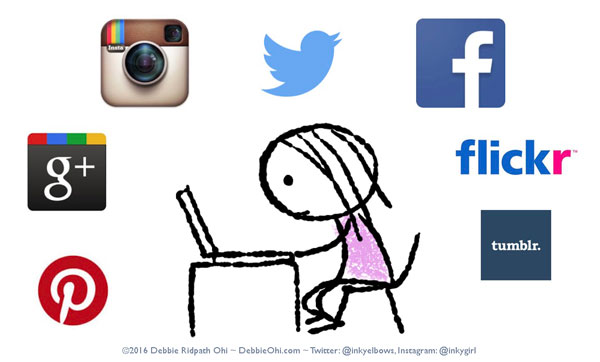
To agents, editors and art directors out there: please take a few minutes to answer a short anonymous poll to help up-and-coming writers and illustrators?
Results will be discussed at the SCBWI-Florida Regional Conference, SCBWI Metro NY Chapter (Feb event) and SCBWI-LA Writer's Day as well as summarized in Inkygirl.com later this year.
For editors and art directors, I'm looking for those who are involved in the decision-making process re: book contracts or initial talent-scouting. Thank you SO MUCH!
You can find results to previous surveys in my Inkygirl Survey Archives.

In preparation for their upcoming online workshop Building a Freelance Illustration Business, Illustrators Salli Swindell and Nate Padavick followed up their article 20 Pieces of Advice from 20 Illustrators by asking art directors for a brief, top-of-mind response to the following question:
“Why would you hire a freelance illustrator a second time?”
Art Directors are a very busy bunch and we thank them all for their time and thoughtfulness.Read on for their insightful responses. Also be sure to check out Salli and Nate’s educational and inspiring online workshop: Building a Freelance Illustration Business here.
HANNAH RAHILL
VP Associate Publisher, Ten Speed Press
“I would hire a freelance illustrator for a second time if they over delivered! Skill, flexibility, patience, and collaboration are what I value most.”
KATHY MCCONAUGHY
VP Creative Development , American Greetings
“I would hire someone again based on the quality of work and how hard I had to work to get it.”
JULIE GOH
Art Director, Going Places, Malaysian Airlines In-Flight Magazine
“I would hire a freelance illustrator for a second time if he/she was someone who is conscientious and delivered his/her work on time. It’s very likely that he/she would have already been producing the kind of work I like as otherwise I would not have hired him/her in the first place.”
CECI BUTLER
Art Director, Design House Greetings
“Well I am assuming that I like their style and art or I would of not have hired them the first time. I will hire them again and again if – I find the artist easy to work with – fun, pleasant, open to feedback. They have to be willing to tweak their designs to fit our needs and art direction. I know that many artists are concerned about their look and their brand but we need to ensure that our product will sell and if that means we need to alter the image we need to have artists who are willing to work with us.
If they provided the above and get their work in on time and in a professional format I would hire them again.”
LYNNE SHLONSKY
Senior Art Director New Product Concepts, American Greetings
“Awesome delivery of the goal ON TIME.”
CAITLIN WILSON
Associate Product Manager, Mary & Martha
“There are 4 things I look for in every freelance illustrator we work with:
~The illustrator’s raw talent
~Their ability to take a design concept and creatively flush it out
~Effective collaboration and communication with director ~Timeliness.”
JEREMY BLACK
Managing Partner, Jasper + Black
“We work with design talent globally and two attributes set apart those we work with again: project management and communication:
Project Management: It’s critical that our collaborators understand the importance of managing against deadlines. There is nothing more frustrating or disappointing than receiving questions about the project a day before it is due. We need our collaborators to set aside time to think, develop, revise, and finalize. Decline a project if you don’t have the time, I’ll respect you more for it.
Communication: From confirming the receipt of a creative brief, providing a timeline and budget, to discussing the creative brief in further detail, communication is critical. Know when the phone is better than email to communicate, and vice versa. If you have specific questions or want to provide an update, use bulleted emails … it helps even the poorest of writers to organize their thoughts.”
FOREST EVASHEVSKI
Art Director, Wall Street Journal
“I usually hire an illustrator a second time if they are easy to work with and timely.”
TOM VITUJ
Senior Director of Creative, Design Design, Inc.
“I would hire an illustrator a second time if:
~Their designs were current and on trend with what I was looking for.
~They were flexible and easy to work with.
~Their art files were very well organized and complete. ~If I needed additional art to complete a product…such as art for a gusset on a paper gift bag or a border on paper tableware, and they were happy to oblige.
~They used our contract and made few or no revisions to it.
COLLETTE KULAK
Senior Creative Planner, Hallmark
“My answer would be that they meet or exceed my main goal of the project (assuming it’s a visual one). They deliver what I’m looking for and hopefully more…over and above would guarantee a second time with them.
Note – deadline also plays into it of course, a fast worker is a dream but the end goal is to get the visual I need. ”
MARY ANN HALL
Editorial Director, Quarry Books and Rockport Publishers
“When you get the work, and you just say YES. This nails it. This is finished, perfect, thought-out, ready to sail. Or, if you want a little tweaking, they are flexible and happy to accommodate, explore different options, and just keep trying things until everyone feels it’s right. Either scenario leaves me wanting to work with someone again.”
PATTY FLAUTO
Color & Design Consultant
“Low maintenance – they need to prove themselves before asking for this, that and the other.”
KRISTEN HEWITT
Design Director, Chronicle Books
“The main thing I would consider before hiring a freelancer for a second time, apart from the quality of their work, would be the experience that I had working with them the first time. Was it a good work experience? Were they pleasant to work with? Were they good communicators (i.e., did they ever go M.I.A. for a period of time and/or never email me back—more people than you would think do this!)? Were they (relatively) on time with their deliveries? These are all questions I would ask myself and the answers would factor into my decision to work with a freelance illustrator again.”
LORI PEDRICK
Art Director, Yankee Magazine
“My answer would really be related to collaboration. Of course skill and ingenuity is key but one of the most important things for me when working with freelancers is the ability to collaborate and offer resourceful solutions to problem solving and a collaborative spirit knowing that with editorial there is a team-like atmosphere and remembering that they are working for a client and while they are being hired for their aesthetic and style, there needs to be some level of flexibility.
As a side note, I always tell any creative who asks about how to pitch to a client, you really need to know their brand and their following or their brand identity and who their core readership is. I wouldn’t propose your work unless you really know that brand and feel that your work is suitable. That is the best way to get noticed, show the client how your vision fits into their brand.”
MADGE BAIRD
Managing Editor, Gibbs Smith
“I would hire an illustrator for the second time because the first time they were able to creatively respond and adapt to art direction for the first project.”
ROGER FRANK
Partner/Creative Director, Little Jacket
“If the working partnership was as remarkable as the work product, then I’d gladly hire a freelance illustrator a second time.”
ELIZABETH STUMBO
Art Director, Meredith Corporation
“I would gladly hire an illustrator a second time who has proven that they can be flexible and are not only willing, but happy to make changes to their artwork to better align with editorial content and opinion.”
DAWN EIDEN
Studio Director, CSS Industries
“I would hire a freelance illustrator the second time around if they met the deadline, provided organized, user friendly files, understood the product and end user and checked in before the assignment was due for feedback.”
SALLY FARR
Art Director, Telegraph Media Group
“If I had had a good experience working with an illustrator before, I will use them again. It’s a given that I like their work for the appropriate job. Keeping to deadlines is key, and where clients are involved, it’s even more important, as with those jobs, we have to take into account various other people and deadlines too.”
SALLI S. SWINDELL
Co-founder of They Draw & Cook, Studio SSS
“I would hire an illustrator again and again if I could sense a bit of their personality and joy in the art. Otherwise it feels like assembly line imagery. I like to think the artist enjoyed the project.”
Thanks to Salli Swindell and all the Art Directors who shared their thoughts. Be sure to check out Salli and Nate’s upcoming 3-Day online workshop: Building a Freelance Illustration Business.
Here is my very first portfolio - the 30 lb 'jumbo boy'. It was gigantic and filled with astounding work! Art directors loved it. They ate it up like cake.
Each new portfolio I made got smaller and smaller until now they fit on an iPhone. But there's something to be said for the 'Jumbo Boy'. Art directors had to clear their desk just to look at it.
I think the amazing thing is that I drew those in ink straight onto the newsprint page without any pencil or rough sketch. I loved how the fountain pen ink sank into the newsprint.
In prep for my workshop at CANSCAIP's Packaging Your Imagination, I asked literary agents, editors and art directors a few questions about whether they research potential clients, authors and illustrators online and what they look for. 18 editors (some of whom also look for picture book illustrators), 8 agents and 2 art directors responded.
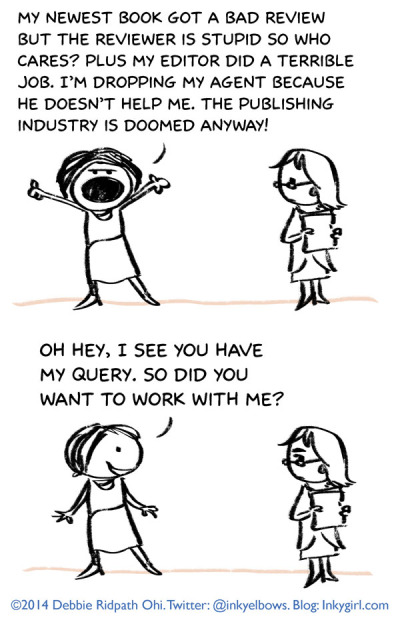
Here's what they said:
QUESTION: When you are considering taking on a new client/author/illustrator, do you ever research them online?
77% of respondents said that when they are considering taking on a new client, author and illustrator, they ALWAYS research them online. The rest said they sometimes do.
QUESTION: If you do online research before signing on a client/author/illustrator, has your research ever made you decide NOT to sign them on?
62% said that YES, they have decided to reject someone after researching them online. Some said that while they hadn't yet rejected someone after online research, they would definitely think twice about signing with someone who posts a lot of negativity (see below) or posts "with cringe-inducing syntax."
OTHER COMMENTS:
In this section, I invited respondents to volunteer additional comments, including turn-ons and turn-offs, what they look for during online research.
The following respondents gave me permission to use their names.
 Christie Harkin, Consultant Publisher at Clockwise Press:
Christie Harkin, Consultant Publisher at Clockwise Press:
"I have been turned off by authors/illustrators who bad-mouth their editors/publishers/agents. It is amazing to me when I see this on Facebook. Even if you don't mention your editor/publisher by name, it is usually very obvious to whom you are referring. I would definitely think twice about taking on someone who did this. Also, I look for authors/illustrators who are generous in sharing news about others in the community. People who only post promo about their own books (BUY MY BOOK! LOOK AT MY STUFF!) are not generally as well-received or connected with the larger community. If you are a new or emerging creator, you need to be engaging with others who are also plugged in to the kidlit world."
 Andrew Karre, Editorial Director at Carolrhoda Books:
Andrew Karre, Editorial Director at Carolrhoda Books:
"An extent online presence is not a necessity. It's gravy. But . . . I place a certain amount of value on a social media presence that seems human and natural and interesting. A Twitter stream that is full of interesting engaged conversations on a variety of topics--even topics other than books--is somewhat more interesting to me than one that is all review links and retweets. I don't much care how many followers. (Unless, of course, it's a huge number, because I am not an idiot about what that means.)"
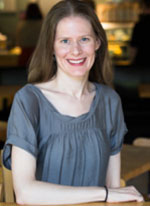 Carol Hinz, Editorial Director at Millbrook Press:
Carol Hinz, Editorial Director at Millbrook Press:
"I'm not necessarily looking for something in particular when I look up an author or illustrator. I simply want to find out if the person has a web presence and, if so, what it is. It's also helpful to get a sense of what else they've done, how they present themselves, whether they do school visits, and what helpful connections they may have (whether it's with other writers, educators, booksellers, etc.) when it comes to book promotion."
Other Comments:
NOTE: Most of the respondents answered anonymously but to avoid the awkward he/she decision, I decided to use "he" or "she" randomly.
One agent said she decided not to request material from previously published authors who got combative with reviewers. Another respondent said that while he hadn't yet rejected a project based on online research, he may make a note to discuss proper online etiquette with that particular author or illustrator. "But I believe the day is coming where my online research will make me answer 'no' when I question, 'Do I love this book enough to want to deal with THIS'?"
Another respondent said that online research sometimes makes her ask more questions, change the direction or focus of the conversation, dig deeper ("and not always in a negative way"), sometimes for the benefit of both of them and sometimes in ways that lead to more meaningful partnerships.
"Biggest turn-off: Writers who get argumentative and/or rude with reviewers and bloggers online. I also look at blog and social media posts that see how the writer comes across in their daily interactions. I'm wary when a writer acts rude, cynical, prejudiced, or pessimistic on social media. That's not to say that people can't have down moments, but if their overall feeds are full complaints and abuse toward others, it's an immediate "no." I've been lucky, though, to have found clients who are all positive, dedicated writers open to criticism and growing in their craft."
"I'm usually just looking for more information and/or to confirm my initial impression. I do notice if someone writes extensively about the writing and publication process ("got another rejection today!") or if he/she does a lot of self-publishing. Neither of these are deal-breakers at all, but they present unique challenges. I actually do most of my sleuthing with agents and agencies, and in that case I do judge if I see a lot of awful self-published covers (but again, may still work with them). Also, I assume writers and agents research me online but the less I'm reminded of that, the better—like don't start every email to me by mentioning something I've posted on Facebook. I don't like the feeling of someone friending me on social media in order to 'gain access.'"
"I look for obviously divisive posts, things that I see that I think would turn off a readership. Professionalism online is important, and also gives me an idea of what you'd be like to work with. I also look to see how you interact with others on your blog/twitter/site whether or not you acknowledge people who leave comments or tweet with you."
"Turn offs= being unprofessional/rude/inappropriate in a public online setting. Why would I want someone with that type of behavior linked to me as an agent and the agency as a whole?"
"When researching someone online, I'm generally just looking to flesh out my knowledge of that person in advance of a possible acquisition. I'm not actually looking for trouble spots, just maybe things to discuss at an IRL meeting with colleagues (sales points) or with the author themselves (small talk). When it's an illustrator, particularly; I do a lot of triage online before anyone's necessarily aware that I'm looking - I use online portfolios to identify leads. I'd advise artists to have as much art available to view online as possible. Use places like deviantart if you don't have a well-maintained personal site or an illustration agent with a good easily searchable site. Probably use deviantart even if you do. The easier your work is to find, the more work you'll pick up. I've been involved in acquisitions where a Google search turned up a certain amount of Internet Drama. It never really influenced the decision - we signed people up each time. I could imagine scenarios in which it would be a deal-breaker - for example, if we discovered that an author was a Neo-Nazi, that wouldn't play well - but none of them has so far come to pass. Incidentally, I think the situation in which duly diligent research is crucial is if you are an author or illustrator being offered work by a publisher or agent. You need to check out the bona fides of the person or company asking to contract with you, because there are an awful lot of sharks out there." - @iucounu on Twitter
"Turn ons - lots of work with the same energy and talent that brought the illustrator to my attention in the first place. Turn offs - samples that look dated, have styles that are very different and less appealing to me than the first sample I saw, very few samples."
"Online turn-offs: people who tweet way too often, people who only speak and don't engage others in conversation, people who are far too self-promotey, people who share way too much of their personal lives, people who are far too neurotic (tweeting constantly about writing woes and insecurities), people who are far, far, far too negative about anything and everything, and the biggest of all: people who feel the need to insult other writers/houses/editors/agents. Oh, and also, writers who quote themselves online. Online turn-ons: people who engage in meaningful discussion (without hitting me on the head with a hammer), people who find that balance between an online persona and being who they really are, people more interested in building a community than shilling their work, people who are endlessly supportive of fellow writers (without being obnoxious about it). What I really want to learn when I research a writer online is what they're after. Did they write the book to jump on the gravy train, hoping it would be the quick path to fame and fortune? Did they write the book because they scoff at the genre they just wrote and wanted to prove anyone could do it? Or is this someone who is serious about building a writing career and not just receiving the adulation of thousands of strangers? THAT'S the writer I want to work with. Someone dedicated to their craft and not their number of Facebook friends or Twitter followers."
(On whether they have rejected someone after online research) "Not if I really, really love the book, but if an author has exhibited abrasive or unpleasant behavior online, it definitely makes me think twice about signing them. When I sign someone, I'm not just signing up the project--I'm going to have to work with the author for a long time, and I prefer not to invite a headache into my life. While a great web presence is a definite plus, I'd never turn someone down for a lackluster web presence. But if I discover combative, difficult behavior, etc, I have to decide if this person is worth the unpleasantness they'll likely bring to my life. Because people are usually consistent--ie, if they're unpleasant to some people, they'll probably be unpleasant to me too if and when any difficulties in our working relationship arise."
-----
Curious about my other publishing industry surveys? Feel free to browse current and past Inkygirl Surveys online.
I have a hard time understanding sometimes why art directors choose the art they do. And sometimes I submit several versions just because I like a different look, and then offer them the choice.
I almost always know what will be chosen, but I keep on sending different things just because. I have my own ideas of what looks best, but then, it' isn't up to me, at least for now.
Which of these would you choose?
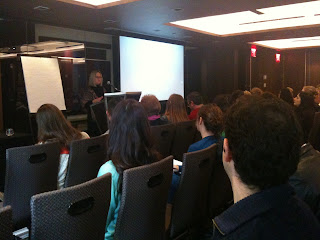 |
| Isabel Warren-Lynch speaking at her "What Hooks Me" Session |
Isabel Warren-Lynch has worked in children's books since 1980 starting as a designer at E.P. Dutton where she passed by the original Winnie-the-Pooh in the lobby every day. In 1985 she was introduced to mass market formats and became the Art Director at Grosset & Dunlap. In 1991 she returned to trade publishing at Random House as the Art Director for Crown Books for Young Readers. Her job has grown over the last 20 years and she now oversees a group of 11 designers work on over 300 books a year on the Random House imprints including Knopf, Delacorte, Wendy Lamb Books, Ember, Bluefire and Dragonfly. As Executive Art Director, she has worked with the best editors and some of the most exciting authors and illustrators in the business.
Isabel wants us to consider emotional connection through illustration.
When you're going through portfolio after portfolio, there has to be some emotional connection to pull you in.
She's showing us some images that grabbed her early on - among them Garth Williams (like the ones for Charlotte's Web) and E. H. Shepards' "Winnie The Pooh" and Maurice Sendack ("Higglety Pigglety Pop! or there must be more to life") - and unpacking how each composition lets us know what the story is about at heart.
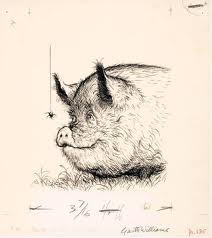 |
| How he could take two of the ugliest animals "...but the love you see there." |
And now she's sharing what's new that she LOVES. Among the examples are"I Was A Rat" by Philip Pullman, a MG illustrated by Kevin Hawks,
 |
| How something could be sweet and funny and sad all at the same time... |
and Leo and Diane Dillon's ilustrations of "The People Could Fly" by Virginia Hamilton.
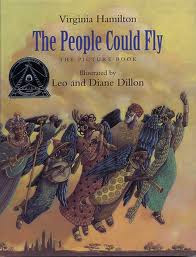 |
| How the composition is like dance |
She's discussing subtleties of expressions, foreshadowing, interactions between characters, body language and position, hair, clothes, movements, muscles, shapes, economy of line...
She worked on Barack Obama's Of Thee I Sing: A Letter To My Daughters, illustrated by Loren Long, and tells us the story behind that book and its remarkable illustrations.
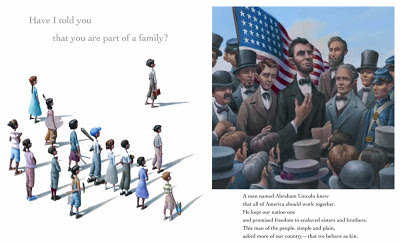 |
| An interior spread |
Isabel discusses how to best present your work as an illustrator (she's sharing that last night at the portfolio review she collected many dozens of postcards!) She's holding up examples of smart promotion and explaining why she liked them. She's also talking about how book dummies reveal your understanding of pacing and layout, answering if you can you carry through a story and characters.
Some Advice:
Before you submit, visit the publishers' websites and look at their books - and ask yourself, could I see my illustration style sitting next to their books?
There's an eager Q&A, and from that this comment that summed up Isabel's session nicely:
"It can be beautiful beautiful beautiful... but we're visual storytellers. It has to tell a story."
Thanks, Isabel!

By: Kathy Temean,
on 8/20/2011
Blog:
Writing and Illustrating
(
Login to Add to MyJacketFlap)
JacketFlap tags:
Agent,
Editors,
agents,
opportunity,
Art Directors,
Editor & Agent Info,
need to know,
Conferences and Workshops,
Application Form,
Add a tag
New Jersey SCBWI File Form for Editors, Agents, and Art Directors
We are scheduling for future events. If you have attended any of our events in the last 18 months, we most-likely have your information on file and do not have to fill this out. Though it would be a nice way to remind us that you would like to come back if you want to fill it out, but not really necessary. Otherwise, if you would like to be considered for any of our events, please fill this out. Printable form link at bottom.
Name:_____________________________________________________________________
Title:____________________________________________________________________
Address: _________________________________________________________________
Phone number:_____________________________________________________________
Email:____________________________________________________________________
Submission guidelines:________________________________________________________
________________________________________________________________________________
Please provide a yes or no as far as your interest in the following (feel free to add qualifiers, such as yes to fantasy, but not high fantasy, or yes to historical fiction, but curriculum-related only)
Picture Books:
Rhyming Picture Books:
Board Books:
Easy Readers/Chapter Books:
Middle Grade:
Young Adult:
Nonfiction:
Graphic Novels:
Historical Fiction:
Fantasy:
Edgy:
Bio: ________________________________________________________________________
_____________________________________________________________________________
_____________________________________________________________________________
_____________________________________________________________________________
_____________________________________________________________________________
_____________________________________________________________________________
Please attach a photo of yourself that we can use.
_____________________________________________________________________________
I would be interested in the following events:
First Page Sessions (held during the week 4-8 pm. includes dinner). Yes _____ No _______
Mentoring Workshops (held on Sundays – requires 8-9 up to 30 page manuscript one-on-one critiques). Yes _________ No __________
Writer’s Retreat (small weekend event held in October 8-9 one-on-one critiques). Yes ____ No _____
Illustrator Days (group of 10 illustrators – pre-day assignment) Yes _____ No ______
Annual Conference Yes ______ No ______ (Friday afternoon 4 PM to Sunday 3pm – ten to eleven, 15 page critiques or six 30 minute consultants, plus editor or agent workshops or first page sessions. Agents need to be available agent pitches and an agent panel). ____________________________________________________________________________________
I am available for the June 8th, 9th and 10th 2012 Conference and would like to be considered: Yes _____ No ______
Editors who can conduct a 45 minute workshop about writing receive higher placement on our conference potential list.
I would be able to conduct a workshop during the conference. Yes_____ No_______
What would you be able to present?______________________________________________
Title of workshop: __________________________________________________________
Description (Please attach outline if necessary) of workshop in 150 words or less:_______________<

By: Kathy Temean,
on 4/11/2011
Blog:
Writing and Illustrating
(
Login to Add to MyJacketFlap)
JacketFlap tags:
HarperCollins,
Events,
illustrating,
authors and illustrators,
opportunity,
Art Directors,
Conferences and Workshops,
Little Brown & Co,
Martha Rago,
PattiAnn Harris,
Add a tag
I would like to introduce you to the two Art Directors doing the NJSCBWI Illustrator Intensive, Conference and portfolio critiques. If you are an illustrator and are serious about making a career in the children’s book Industry and have never worked with an art director on a picture book, you really should think about signing up for the Illustrators Intensive. I participated in our first Illustrators Intensive held a few years back. I have to say, it was a awesome experience. It gives you a first hand look at working with an art director.
You are given an assignment to do a double page spread taken from text supplied before the conference by the art directors. Once you pick the double page spread you want to do, you do a sketch and send it back for the art directors comments. They send back their thoughts and suggestions and then you work to finish the spread and bring it with you on the day of the Intensive.

Patti Ann Harris is Senior Art Director at Little, Brown Books for Young Readers. She started her career in book publishing designing for Cartwheel Books, the novelty imprint at Scholastic. In addition to novelty books, Cartwheel publishes board books, early readers and picture books so she was able to get experience designing a wide range of titles.
PattiAnn will tell you she was lucky to work with a creative group of editors and designers where shewas encouraged to experiment with formats. Novelty books were a focus of hers so she learned a great deal about book production. She created book dummies made from cloth, board and other combinations of materials. It always sparked new ideas for her.
Her experience with novelty books lead her to Little, Brown Books for Young Readers. She was hired to work on their new imprint, LB-kids, which focuses on licensed properties and interactive formats. Early on, LB-kids teamed up with innovative and creative publishing partners. Her role as Senior Art Director grew to include overseeing their picture book list.
PattiAnn says, “I can’t say that there is a specific style of illustration that I’m interested in. I think I’m more drawn to a strong character or a unique point of view. That’s what I respond to most in illustration. I also love to see different media explored like letterpress printing, collage or any blending of traditional medium with digital to invent something new and exciting.”
 Martha Rago is the Executive Art Director for HarperCollins Children’s Books. Her first position was at G.P. Putnam’s Sons as assistant to the Art Director. She progressed from Senior designer at E.P. Dutton to FSG as Art Director, then on to Henry Holt as Creative Director.
Martha Rago is the Executive Art Director for HarperCollins Children’s Books. Her first position was at G.P. Putnam’s Sons as assistant to the Art Director. She progressed from Senior designer at E.P. Dutton to FSG as Art Director, then on to Henry Holt as Creative Director.
Martha oversees the development and design of HarperCollins picture books, including those in the Rayo and Katherine Tegen imprints, the estate programs of C.S. Lewis and Shel Silverstein, and the Blazer & Bray imprint.
Here’s Martha:
A good picture book must begin with a good story, no matter how creative and talented the artist may be. But like an author, artists have a voice, a unique vision that comes through in their work. If their style is the right complement to the text, the visuals give the story additional interest and resonance.
I look for artists that will add another dimension to th
Illustrators attending the conference today can spend each of their three breakout sessions with a real live art director. Let me know if you want me to pinch you all, because this is definitely a dream come true.
There're two pre-conference interviews for
Lucy Ruth Cummins and
Denise Cronin already, and here we have one for Patti Ann Harris! Give Patti Ann the thumb's up or a high five if you see her—she art directed recent Caldecott Honor winner DAVE, THE POTTER.
 |
| Also art directed by Patti Ann |
Jaime: What's your average day like?
Patti Ann: I have to say that there really isn't an average day at the office. Each day is a mix of meetings with editors, phone calls with illustrators, updates with designers, it's a pretty full day. My challenge is always to carve out some quiet time to design and work on my books. There are a few titles each season that I work on from start to finish. Oftentimes, I get a book up and running, sometimes working through the sketch phase or finalizing the details on a new format. Book publishing is a collaborative art and that collaboration has always inspired me. I'm lucky to work with an amazingly talented and dedicated group of designers and editors, so the work day is anything but average. Jaime: Are you currently acquiring illustrators?
Patti Ann: I can't say that there is a specific style of illustration that I'm interested in. I think I'm more drawn to a strong character or a unique point of view. That's what I respond to most in illustration. I also love to see different media explored like letterpress printing, collage or any blending of traditional medium with digital to invent something new and exciting.Jaime: Would you like to give us a hint of what your conference session topic will be?
Patti Ann: I'll be giving an overview of the novelty and picture books that we publish at Little, Brown. Our list has a great variety of books that range from cloth and board books for babies, pop-ups, and other fun novelties to more traditional picture books. I'd like to share some themes and subjects that I think resonate. My goal is to help open up illustrators to the many possibilities in book publishing.Jaime: What's your favorite children's book cover of 2010 (not done by your publishing house)?
Patti Ann: The Quiet Book by Deborah Underwood illustrated by Renata Liwska

By: Adventures in Children's Publishing,
on 8/3/2010
Blog:
Adventures in YA Publishing
(
Login to Add to MyJacketFlap)
JacketFlap tags:
Magazines,
Editors,
Writing for Children,
Andrea Brown Literary Agency,
Art Directors,
Mary Kole,
Illustrators,
Highlights,
Picture Books,
Articles,
Add a tag
Associate agent Mary Kole of the Andrea Brown Literary Agency recently posted
an interesting article on whether a picture book manuscript makes the cut for publication as a stand-alone book, or is better suited as a short story in a magazine. While those of us writing picture books dream of seeing our story on bookshelves, complete with colorful, inviting covers, the picture book market is difficult these days. And if our goal as writers is to write for enjoyment, share it with others, and gain publishing credits, then what's holding us back from seeking publication through a children's magazine?
Last month,
Highlights Editor Debra Hess and
Highlights High Five Art Director Kelley Cunningham spoke at an
SCBWI conference in Maryland. Their presentation made publicaton with their magazine seem both appealing and accessible. They encouraged writers and illustrators to look into their
submission guidelines and submit articles and art samples as a way of gaining exposure. They specifically indicated that they are looking for new talent, but reminded conference-goers to do their homework.
Debra and Kelley's Submission Tips
- Know the market. Look through current issues of Highlights and other children's magazines and see what's being published.
- Separate yourself from your work and prepare yourself for feedback.
- Create a brand for yourself. Have a website and create a mailing/emailing list to spread the word about your work.
- More isn't always better. For illustrations specifically, quality art is more appreciated than numerous samples of lower quality.
- Your manuscript must have merit. If you are submitting non-fiction, they strongly advised including a bibliography. Debra Hess said she won't even look at your article without one.
- Wikipedia is NOT a resource to cite.
- Manuscripts that begin with, "Imagine you are a..."
- Manuscripts that read like a term paper, i.e., they're not child-friendly.
- Writing that isn't clear or concise (they want no more than 750 words per submission).
- Submissions that don't have a clear, consistent point-of-view.
- Not including a reading level or word count.
- Cover letters that lack personality or don't demonstrate that you can write for kids.
- Queries. That's right, they don't want queries. Articles and short stories are brief enough that they want a cover letter and your complete submission.
Kelley's Tips for Illustrators- Stay open-minded to changes they propose in the editing process.
- Kelley Cunningham emphasized the need for true artistic talent, and commented that nothing replaces good, old-fashioned drawing skills.
- They don't want links to complicated, slow-l

By: Adventures in Children's Publishing,
on 7/12/2010
Blog:
Adventures in YA Publishing
(
Login to Add to MyJacketFlap)
JacketFlap tags:
Getting Published,
Query Letters,
Editors,
Book Deals,
Manuscripts,
Agents,
Writing for Children,
SCBWI Conferences,
Pitch,
Art Directors,
Add a tag
Whether you're attending or not, the 39th Annual SCBWI Summer Conference in Los Angeles, California is just around the corner. There are plenty of big names, fantastic workshops, and enthusiastic writers/illustrators to go around. Take part in our poll below, and read on for all the details.
When: July 30-August 2Where: Los Angeles, CaliforniaWho: Editors, Agents, Publishers, Authors, Writers, Illustrators, you name them...What: Keynote speeches, workshops, individual consultations, and the chance to networkFees: Registration fee of $495 for SCBWI Members, $550 for non-membersIn the spirit of our conference round-ups each Monday, we are looking for reports out of as many workshops as possible. Those of us who can't make it will be grateful if you're up for sharing your take aways. And even if you are fortunate enough to attend the conference, there are countless workshops and not enough time to get to all of them. Take a glance at the list of workshops below and post to comments which workshop(s) you plan on visiting. If you're interested in sharing your notes, please let us know. Be sure to include a way to get in touch with you, or email us at kidlit (at) writeedge (dot) com. Thank you!Workshops: Friday, July 30th- Start: Write Your First Page (Part 1A) [Bonnie Bader]
- Boy Middle-Grade Fiction [Courtney Bongiolatti]
- How to Approach Agents Without Scaring Them Off [Ginger Clark]
- How to Get the Most Out of Your First SCBWI Conference [Tina Nichols Coury]
- Writing Mass Market Fiction [Francesco Sedita]
- The Page-Turner Principle [Gordon Korman]
- How to Think Like a Publisher [Stephanie Lurie]
- Submission Strategies [Josh Adams]
- Think Like a Packager [Claudia Gabel]
- Nailing Age and Keeping it Honest- A Writing Workshop [Amy Koss]
- 5 Lessons from Classic Picture Books that Can Help You Launch Your Career [Marc Barnett & Steven Malk]
- Stories that Cross Borders/Boundaries [Jennifer Cervantes. Christina Gonzalez, & Guadalupe Garcia McCall]
- Writing for the Tween Market:
I attended three illustration workshops in January and February. The talks were given by Steve Metzler (Dutton), Patrick Collins (Henry Holt), and Regina Griffith (Egmont). Here are some notes from those sessions that I thought might help both illustrators and writers.
Steve Metzler gave a talk about Dutton, then reviewed several portfolios, including mine. I learned almost as much from what he said about other portfolios as I did from what he said about mine. If you have a chance to have him review your portfolio, take it.
- Characters are selling in picture books and graphic novels, especially quirky characters (like Fancy Nancy, Skippy Jon Jones, Diary of a Wimpy Kid, and Baby Mouse).
- A good character leads to a good story.
- He likes to see people in portfolios, not just animals.
- 2012 is supposed to be the height of the new PB market (baby boom in 2006).
- If you’re an illustrator, also be a writer.
- He works on everything from PB to YA.
- Sees a need for graphic novels for boys (7-9 year olds).
- Don’t ever do a PB dummy where it’s all the same (all full page spreads, all vignettes, all single pages, etc.)
Patrick Collins gave portfolio reviews to three lucky people, followed by Q&A at a local SCBWI meeting. He didn’t review my portfolio, but I learned a lot from the portfolios he did review.
- A publisher might choose your art or your writing, but not always both – even if you do both.
- Try to have a focus in each image. How do you get the focal point of the image to come forward and have everything else fade into the background? Try varying the tones/values.
- Kid’s books are all about characters and storytelling.
- Pay attention to how you draw people and animals and how you incorporate them into your backgrounds.
- You really need to put in the time to make progress if you want to have a career in art.
- Make sure you have character in your characters. They should look like living people, not mannequins. (You can achieve this through expressions, body language and interaction between characters.)
- Need to have more than one perspective/point of view.
- Think about how you can show focus in a busy image. You don’t want people to miss the important part of the scene.
- The reason an art director looks for a consistent style is so they know what you can/will do if they hire you. You can always market a different style later. Show your best style at the time.
Regina Griffith gave a talk about Egmont, then reviewed several portfolios, including mine. As with Steve Metzler’s talk, I learned almost as much from what she said about other portfolios as I did from what she said about mine. Regina was really great about reviewing a portfolio and then talking about what was working or not with the whole group. If you have a chance to have her review your portfolio, take it.
- Not publishing many PBs right now. Focusing on older books.
- She’s looking for a broad range with real kid appeal.
- Most of the books on their list right now are US books, but they do have a couple that are foreign books.
- No graphic novels yet, but maybe in the future.
- Can’t imagine not liking animals in clothing. It depends on the text though. (In response to a question about anthropomorphized animals.)
- Picture books should have a plot.
- In a crowd scene, everyone should have different personalities.
- Page turn surprises in picture books are a good thing.
- It’s good to show you can fill a page with spots/vignettes or with full page spreads.
- It’s good to have black and white images in your portfolio when picture books are in a slump.
















 Martha Rago is the Executive Art Director for HarperCollins Children’s Books. Her first position was at G.P. Putnam’s Sons as assistant to the Art Director. She progressed from Senior designer at E.P. Dutton to FSG as Art Director, then on to Henry Holt as Creative Director.
Martha Rago is the Executive Art Director for HarperCollins Children’s Books. Her first position was at G.P. Putnam’s Sons as assistant to the Art Director. She progressed from Senior designer at E.P. Dutton to FSG as Art Director, then on to Henry Holt as Creative Director.



I found this talk to be one of the most deeply effecting moments of the entire weekend. I had a bit of an epiphany after this talk about my own illustration work. I tend to focus heavily on making it "beautiful"- but as was said in the summation "it has to tell a story". The examples of the line drawings from Charlotte's Webb which so perfectly convey the deep emotional connections between characters really brought this point home for me. Thank You for such a great talk!